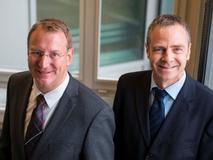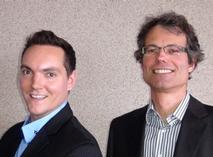10 questions to our venture kick winners!
14.04.2014
The jury awarded Twingtec and CALCISCO, each of them winning CHF 130’000, the maximum funding granted by venture kick. TwingTec, an EMPA spin-off, develops and markets a new wind energy technology. CALCISCO, based at the University Hospital Bern, develops and commercializes the first diagnostic blood test available for the early detection of calcification propensity in patient blood.
 Andreas Pasch and Matthias Meier, CALCISCO founders
|
 Corey Houle and Rolf Luchsinger, TwingTec founders
|
How and why did you launch your startup?
Matthias Meier, CALCISCO : Dr Andreas Pasch and I first met at a large Swiss-wide research initiative (NCCR Kidney.CH). When Andreas in 2012 published his novel blood test (T50 test) for determining the calcification propensity in blood, we started to think about a possible commercialization of the T50 test. After a first evaluation of the in-vitro diagnostic market potential, and after several discussions with friends and former colleagues from the medtech and biotech field, we decided to participate in VK I. Short after we founded CALCISCO AG.
Rolf Luchsinger, TwingTec: About six years ago we started to build at Empa large kites with our new light-weight structure Tensairity in order to learn, how this can be integrated into wings. This worked so well that we suddenly understood we discovered the key to build the highly efficient, ultra-light kites needed to harvest wind energy. In parallel, Corey Houle at FHNW looked into ways to produce electrical power with kites. When he saw our new kites on the Swiss TV show Einstein, he contacted us. This was like a perfect match: we had the wing, he had the ground station and power electronics. So we teamed up, managed to get a two years joint research project granted, made the proof of concept and launched TwingTec last summer.
What stage of its development is CALCISCO today? What are the next steps?
MM: In the meantime we started our operations at Inselspital Bern, where we setup our own R&D laboratories. We have two developer employed helping to optimize the T50 test for routine clinical application. Today the test already runs in a research setup and is offered as research service. We hope to be able to offer the test by the end of this year already for to the doctors for clinical use at Inselspital in Bern. By the end of 2015 we plan to have the T50 test validated and CE marked for the use in Europe.
How is TwingTec positioned regards to your competitors (on the market)?
RL: Our product generates electrical energy out of the wind. Compared to a wind turbine, our system doesn’t need a tower and a foundation. We can save up to 90% of the material of a wind turbine. Furthermore, we can fly higher up where there is stronger and more consistent wind. As a result, the costs of energy are considerably lower than for a wind turbine. Our mobile system has a minimal environmental impact and opens up new options and sites both on- and off-shore for wind power. There are also a number of competitors developing similar kitepower systems. Here we differentiate by our unique wing and control concept which allows for maximal safety and efficiency.
Why did you apply for venture kick?
MM: Venture kick provides an excellent opportunity to present your idea to a professional and critical audience. And with a bit of luck, by passing the first round, venture kick helps to continuously improving your idea and forming a real business project.
Explain how the venture kick program helped TwingTec?
RL: venture kick covers the unique time of a start-up a few months before incorporation until a few months after. During this time, we got a frank feed-back to our plans and business, we had three opportunities to pitch and finally, we got some money, too. It’s a bit like the Voice of Switzerland: guiding no named potentials to the verge of having an impact. And this in a highly inspiring and professional way. It’s a competition, you go for it, you give it all but in the end, whatever happens, you can only win.
How did you convince the jury?
MM: Difficult question, maybe some of the jury members better should answer this. However, two main points might have been the large business potential and the team behind it.
What kind of advice would you give to another young entrepreneur?
RL: Talk to people, spread the news, listen, learn and adapt. You can find good support for start-ups in Switzerland. Make use of it!
Why would you recommend the venture kick program to other startups?
MM: The venture kick program gives you not only the chance to win some money, but to pitch, and to learn to sell your vision. And you might get the opportunity to also participate in the exceptional helpful kicker’s camps.
What do you think is the impact of the venture kick program on the Swiss startup industry?
RL: If one sees how many of the successful Swiss startups over the last years have gone through it, vkick obviously must have an impact. For us, venture kick really made a difference.


